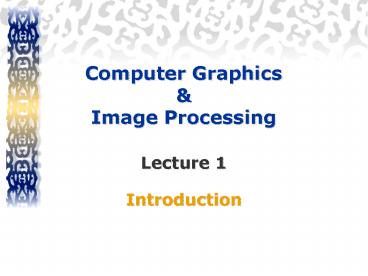Computer Graphics PowerPoint PPT Presentation
Title: Computer Graphics
1
Computer Graphics Image ProcessingLecture 1
Introduction
2
- ROBIN WALIA
- Lecturer
- ECE DEPARTMENT
- MMEC, MULLANA-AMBALA
- Email robinwalia1_at_gmail.com
- Office Room 220
3
Text Book (s)
- Gonzalez, R. C. and Woods, R. E., Digital Image
- Processing, Second Edition, Pearson-Prentice
Hall, - Inc., 2002. ISBN 81-7758-168-6.
- Gonzalez, R. C., Woods, R. E., and Eddins, S. L.,
- Digital Image Processing Using MATLAB,
Pearson-Prentice Hall, Inc., 2004, ISBN
81-7758-898-2.
4
Computer Graphics
- Graphics are visual presentations on some
surface, such as a wall, computer screen, paper,
or stone to brand, or entertain. Examples are
photographs, drawings, graphs, diagrams, maps,
engineering drawings, or other images - Computer graphics are graphics created using
computers and, more generally, the
representation and manipulation of pictorial
data by a computer. - Developments in computer graphics have had a
profound impact on many types of media and have
revolutionized the animation and video game
industry.
5
Computer Graphics
- The term Computer Graphics has several meanings
- the representation and manipulation of pictorial
data by a computer - the various technologies used to create and
manipulate such pictorial data, and - the images so produced
6
What is an Image?
- Image is a source of information according to
information theory - An image may be defined as a two dimensional
function f(x,y) where x and y are spatial
coordinates and amplitude of f at any pair of
coordinates (x,y) is called the intensity
or Gray level of the image at that point.
7
Digital Image
- When x,y and the amplitude values of f are all
finite, discrete quantities, we call the
image a Digital Image. - A digital Image is composed of a finite number
of elements each of which has a
particular location and value - These elements are referred to as Picture
Elements, Image Elements, Pels or Pixels.
8
Pixel
- In digital imaging, a pixel is the smallest piece
of information in an image. - Pixels are normally arranged in a regular
2-dimensional grid, and are often represented
using dots or squares - The intensity of each pixel is variable in color
systems, each pixel has typically three or four
components such as red, green, and blue, or cyan,
magenta, yellow, and black
9
Why do we Process Images?
Facilitate picture storage and transmissionEnha
nce and restore imagesExtract information from
imagesPrepare for display or Printing
10
EM Spectrum
11
Key Stages in Digital Image Processing
Image Restoration
Morphological Processing
Segmentation
Image Enhancement
Image Acquisition
Representation Description
Object Recognition
Problem Domain
Color Image Processing
Image Compression
12
Key Stages in Digital Image ProcessingImage
Acquisition
Image Restoration
Morphological Processing
Segmentation
Image Enhancement
Image Acquisition
Representation Description
Object Recognition
Problem Domain
Color Image Processing
Image Compression
13
Key Stages in Digital Image ProcessingImage
Enhancement
Image Restoration
Morphological Processing
Segmentation
Image Enhancement
Image Acquisition
Representation Description
Object Recognition
Problem Domain
Color Image Processing
Image Compression
14
Key Stages in Digital Image ProcessingImage
Restoration
Image Restoration
Morphological Processing
Segmentation
Image Enhancement
Image Acquisition
Representation Description
Object Recognition
Problem Domain
Color Image Processing
Image Compression
15
Key Stages in Digital Image ProcessingMorphologi
cal Processing
Image Restoration
Morphological Processing
Segmentation
Image Enhancement
Image Acquisition
Object Recognition
Representation Description
Problem Domain
Color Image Processing
Image Compression
16
Key Stages in Digital Image ProcessingSegmentati
on
Image Restoration
Morphological Processing
Segmentation
Image Enhancement
Image Acquisition
Representation Description
Object Recognition
Problem Domain
Color Image Processing
Image Compression
17
Key Stages in Digital Image ProcessingRepresenta
tion Description
Image Restoration
Morphological Processing
Segmentation
Image Enhancement
Image Acquisition
Representation Description
Object Recognition
Problem Domain
Color Image Processing
Image Compression
18
Key Stages in Digital Image ProcessingObject
Recognition
Image Restoration
Morphological Processing
Segmentation
Image Enhancement
Image Acquisition
Representation Description
Object Recognition
Problem Domain
Color Image Processing
Image Compression
19
Key Stages in Digital Image ProcessingImage
Compression
Image Restoration
Morphological Processing
Segmentation
Image Enhancement
Image Acquisition
Representation Description
Object Recognition
Problem Domain
Color Image Processing
Image Compression
20
Key Stages in Digital Image ProcessingColour
Image Processing
Image Restoration
Morphological Processing
Segmentation
Image Enhancement
Image Acquisition
Representation Description
Object Recognition
Problem Domain
Color Image Processing
Image Compression
21
Applications of Image Processing
22
1. Image Restoration
23
Image Colorization
24
Image Enhancement
25
Face Detection
26
Face Tracking
27
Face Morphing
28
Finger Print Recognition
29
Personal Identification Using Iris
Recognition
30
Image Processing Components
Image Sensing deviceStorage MediaProcessing
SystemsDisplaysCommunication MediaHardcopy
devices (e.g Printer)
31
Camera
Lens (CMount, CSMount, Motorized) Optical
Filter (Selectivity in EM waves) Imaging Sensor
(CCD Sensor) Flash (Used for lighting/Illuminati
on) Front Illumination Back IlluminationDigiti
zer
32
Processing systems
PC based General purpose PCs Servers Indust
rial PCsEmbedded system based DSP processor
based FPGA based System on chip (SoC)
33
Any question

